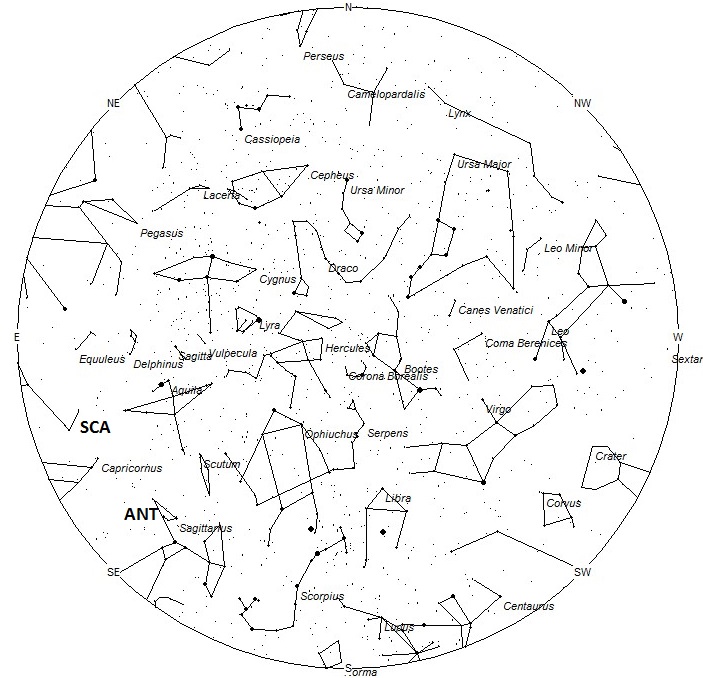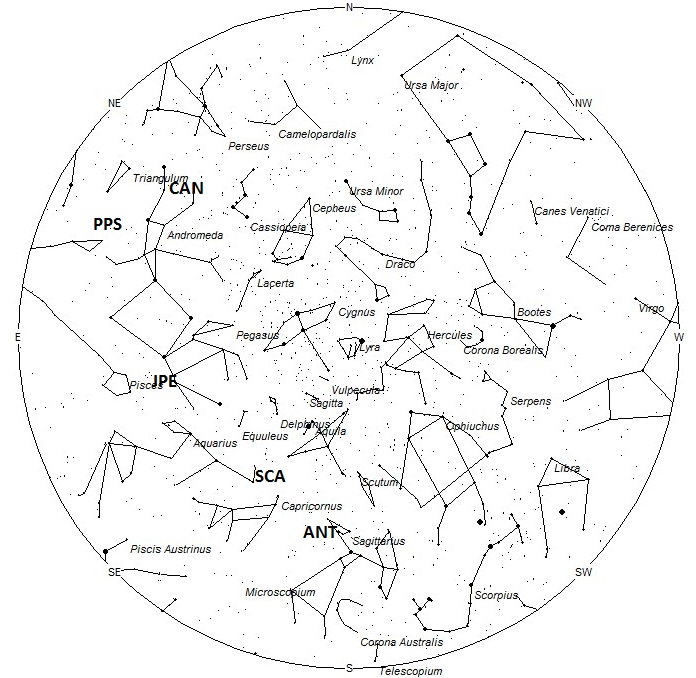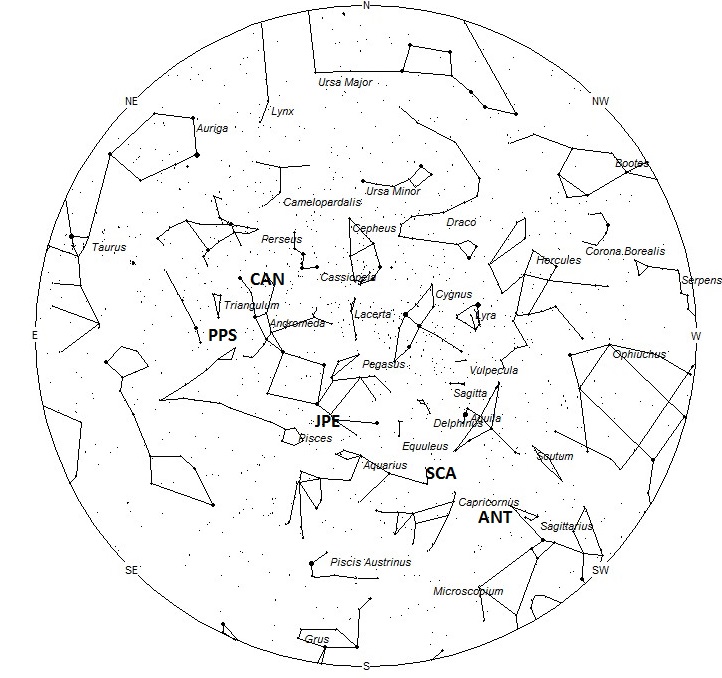
During this period the moon reaches its new phase on Monday July 4th. At this time the moon will lie near the sun and will invisible at night. Toward the end of the period the waxing crescent moon will enter the evening sky but will be too thin and will set soon after the end of dusk to interfere with meteor observing. The estimated total hourly meteor rates for evening observers this week is near 3 for observers located in the northern hemisphere and 4 for observers located in tropical southern locations (25S). For morning observers the estimated total hourly rates should be near 11 as seen from mid-northern latitudes (45N) and 12 as seen from tropical southern locations (25S). The actual rates will also depend on factors such as personal light and motion perception, local weather conditions, alertness and experience in watching meteor activity. Note that the hourly rates listed below are estimates as viewed from dark sky sites away from urban light sources. Observers viewing from urban areas will see less activity as only the brightest meteors will be visible from such locations.
The radiant (the area of the sky where meteors appear to shoot from) positions and rates listed below are exact for Saturday night/Sunday morning July 2/3. These positions do not change greatly day to day so the listed coordinates may be used during this entire period. Most star atlases (available at science stores and planetariums) will provide maps with grid lines of the celestial coordinates so that you may find out exactly where these positions are located in the sky. A planisphere or computer planetarium program is also useful in showing the sky at any time of night on any date of the year. Activity from each radiant is best seen when it is positioned highest in the sky, either due north or south along the meridian, depending on your latitude. It must be remembered that meteor activity is rarely seen at the radiant position. Rather they shoot outwards from the radiant so it is best to center your field of view so that the radiant lies at the edge and not the center. Viewing there will allow you to easily trace the path of each meteor back to the radiant (if it is a shower member) or in another direction if it is a sporadic. Meteor activity is not seen from radiants that are located far below the horizon. The positions below are listed in a west to east manner in order of right ascension (celestial longitude). The positions listed first are located further west therefore are accessible earlier in the night while those listed further down the list rise later in the night.
These sources of meteoric activity are expected to be active this week.
The center of the large Anthelion (ANT) radiant is currently located at 19:36 (294) -22. This position lies in eastern Sagittarius, 5 degrees east of the the 4th magnitude star known as pi Sagittarii. Due to the large size of this radiant, Anthelion activity may also appear from the nearby constellations of Scutum, Serpens Caput, southern Aquila, and western Capricornus as well as Sagittarius. This radiant is best placed near 0100 local daylight saving (LDST), when it lies on the meridian and is located highest in the sky. Hourly rates at this time should be near 1 as seen from mid-northern latitudes and 2 as seen from tropical southern latitudes. With an entry velocity of 30 km/sec., the average Anthelion meteor would be of slow velocity.
The Sigma Capricornids (SCA) were discovered by Zdenek Sekanina and are active for a month lasting from June 19 through July 24. Maximum occurred on June 27th. The radiant is currently located at 20:40 (310) -07. This area of the sky is actually located on the Aquila/Aquarius border, 8 degrees northeast of the naked eye double star Algiedi (Alpha Capricornii). The radiant is best placed near 0300 LDT when it lies on the meridian and is highest in the sky. Rates at this time should be near one per hour no matter your location. With an entry velocity of 42 km/sec., the average Sigma Capricornid meteor would be of medium velocity. This velocity is significantly faster than the stronger Alpha Capricornids, which appear from the same general area of the sky during the second half of July.
The July Pegasids (JPE) have been noticed for some time now but have had a checkered history. It has been added, dropped, and then re-added to several radiant lists. Video studies within the past 10 years has positively identified this source as an active radiant during the entire month of July. Maximum activity occurs on July 10th. The radiant is currently located at 22:48 (342) +09. This area of the sky is located in southern Pegasus, 2 degrees southeast of the 3rd magnitude star known as Homam (Zeta Pegasi). This area of the sky is best seen during the last dark hour before dawn when the radiant lies highest in a dark sky. Rates are expected to be less than 1 per hour this week no matter your location. Rates should increase to near 2 per hour at maximum. With an entry velocity of 68 km/sec., the average meteor from this source would be of swift velocity.
The Pi Piscids (PPS) were discovered by Dr. Peter Brown in his meteoroid stream survey using the Canadian Meteor Orbit Radar. This shower was later verified by Dr. Peter Jenniskens and David Holman using data from the CAMS network in northern California. These meteors are active from June 11 through July 25 with maximum activity occurring on July 1st. The current position of the radiant is 01:08 (017) +26. This position lies in northern Pisces, 9 degrees south of the 2nd magnitude star known as Mirach (beta Andromedae). Rates are currently expected to be near 2 per hour as seen from the northern hemisphere and 1 per hour as seen from south of the equator. With an entry velocity of 68 km/sec., the average Pi Piscid meteor would be of swift speed.
The c-Andromedids (CAN) was discovered by Sirko Molau and Juergen Rendtel using video data from the IMO network. Activity from this source is seen from June 26 though July 20 with maximum activity occurring on July 12. The radiant currently lies at 01:28 (022) +44, which places it in northern Andromeda, 8 degrees northwest of the famous double star known as Almach (gamma Andromedae). This area of the sky is best seen during the last dark hour before dawn when the radiant lies highest in a dark sky. Observers in the northern hemisphere are better situated to view this activity as the radiant rises much higher in the sky before dawn as seen from northern latitudes. Current rates would be less than 1 per hour no matter your location. With an entry velocity of 60 km/sec., the average meteor from this source would be of swift velocity.
As seen from the mid-northern hemisphere (45N) one would expect to see approximately 7 sporadic meteors per hour during the last hour before dawn as seen from rural observing sites. Evening rates would be near 2 per hour. As seen from the tropical southern latitudes (25S), morning rates would be near 8 per hour as seen from rural observing sites and 3 per hour during the evening hours. Locations between these two extremes would see activity between the listed figures.
The list below offers the information from above in tabular form. Rates and positions are exact for Saturday night/Sunday morning except where noted in the shower descriptions.
| SHOWER | DATE OF MAXIMUM ACTIVITY | CELESTIAL POSITION | ENTRY VELOCITY | CULMINATION | HOURLY RATE | CLASS |
|---|---|---|---|---|---|---|
| RA (RA in Deg.) DEC | Km/Sec | Local Daylight Saving Time | North-South | |||
| Anthelions (ANT) | – | 19:36 (294) -22 | 30 | 01:00 | 1 – 2 | II |
| Sigma Capricornids (SCA) | Jun 27 | 20:40 (310) -07 | 42 | 02:00 | 1 – 1 | IV |
| July Pegasids (JPE) | Jul 10 | 22:48 (342) +09 | 68 | 04:00 | <1 – <1 | IV |
| Pi Piscids (PPS) | Jul 02 | 01:08 (017) +26 | 68 | 07:00 | 2 – 1 | IV |
| c-Andromedids (CAN) | Jul 12 | 01:28 (022) +44 | 60 | 08:00 | <1 – <1 | IV |
 American Meteor Society
American Meteor Society



Miami beach just before sunrise on July 3rd. Beautiful earth grazer from south west to northeast. Just above the skyline. So bright I thought it was in airplane until I looked at it with binoculars.
I’m 100% I’ve seen a meteor , I live in Dongguan China. This was yesterday, was riding my bike, When I got close to the traffic lights I saw a super bright light going down . I told my girlfriend but it was too late for her to see . That’s why I started searching online about any activity during this days . 280 degrees W direction where I saw it.
July 10 (on the merrit/New Havenish) saw a metoer with my husband while driving. Dark sky bright fast light… Googled activity and it seems spot on.